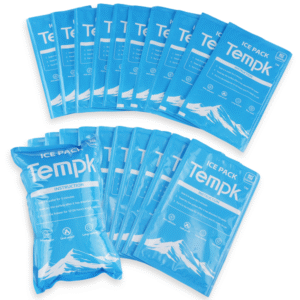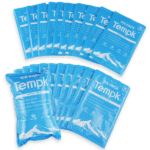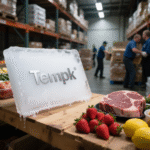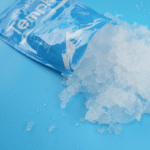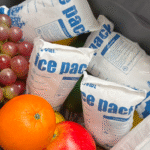Qué hacer con el hielo seco de un paquete: A Complete Guide to Safe Handling and Disposal
hielo seco, a form of solid carbon dioxide, is often used in shipping to keep items cold, bienes especialmente perecederos. But once you receive dry ice in a package, many are unsure how to handle or dispose of it properly. This guide will walk you through everything you need to know about handling dry ice safely, from storage to disposal, ensuring both your safety and environmental responsibility.
-
How to handle dry ice safely to prevent accidents
-
Best practices for storing dry ice before it sublimates
-
Safe disposal methods for dry ice to prevent harm
-
Environmental considerations when using dry ice and sustainable alternatives
How Should You Handle Dry Ice from a Package?
Dry ice is extremely cold, reaching temperatures around -78.5°C (-109.3°F). Improper handling can result in severe injuries, como Frostbite, or more dangerous situations like carbon dioxide buildup in confined spaces. Follow these safe handling techniques:
1. Usar guantes protectores
Nunca touch dry ice with bare hands. Always use insulated gloves or tongs to handle it. This protects you from severe frostbite or burns due to the extremely low temperature.
2. Asegurar la ventilación adecuada
El hielo seco se sublima directamente de un sólido a un gas, releasing carbon dioxide. This gas can replace oxygen in confined spaces, which could lead to suffocation. Always handle dry ice in a área bien ventilada such as an open room, garage, or outdoors.
3. Use an Insulated Container
If you plan to store dry ice temporarily, use an insulated container to slow down the sublimation process. Ensure the container is ventilado to allow the gas to escape, preventing any pressure buildup.
Safety Tip:
Always keep dry ice out of reach of children and pets to avoid accidental exposure to its extreme cold.
What to Do If You Don’t Need the Dry Ice Immediately?
If you don’t need the dry ice right away, it’s important to store it correctly to prevent wastage and avoid safety hazards. Here’s how you can store dry ice safely:
1. Store in an Insulated Container
A cooler or insulated box will help maintain the dry ice’s temperature for longer. Make sure the lid is slightly ajar para permitir que el gas dióxido de carbono escape.
2. Keep It in a Ventilated Space
Siempre guarde hielo seco en un ventilated area to prevent a build-up of carbon dioxide gas. This could be outside or in an open garage, ensuring good airflow.
3. Use It Within 24 Horas
Dry ice will gradually sublimate, so for best results, try to use it within 24 horas after receiving it. The more insulated the container, Cuanto más durará.
How Do You Dispose of Dry Ice Safely?
Once you no longer need the dry ice, proper disposal is crucial to avoid accidents. Here’s how to dispose of dry ice safely:
1. Let It Sublimate Naturally
The safest way to dispose of dry ice is to let it sublimado in a well-ventilated area. Avoid placing it in a sealed container, as the gas it produces could cause the container to burst.
2. Use Warm Water for Faster Sublimation
If you need to speed up the process, place the dry ice in warm water (not boiling) to accelerate sublimation. Be careful of the rapid release of gas and ensure the area is well-ventilated.
3. Avoid Common Disposal Mistakes
-
Never place dry ice in a sealed container: This can cause dangerous pressure buildup.
-
Never throw dry ice in the trash: It can cause the trash bag or dumpster to explode.
-
Never dispose of dry ice down a drain: Its extreme cold can crack pipes.
Safety Tip:
Ensure the dry ice is in a espacio bien ventilado when sublimating, such as an outdoor area or an open room. This will allow the carbon dioxide gas to dissipate safely.
Environmental Considerations of Using Dry Ice
Dry ice is often touted as an eco-friendly alternative to regular ice, but it’s important to consider its environmental impact. Cuando el hielo seco se sublima, libera dióxido de carbono (CO2), un gas de efecto invernadero. Sin embargo, because dry ice doesn’t produce liquid waste, it’s considered cleaner than traditional ice.
1. CO2 Emissions
Dry ice is made from CO2 captured during industrial processes. While it doesn’t create physical waste, its sublimation still releases CO2 into the atmosphere, contribuyendo a las emisiones de gases de efecto invernadero.
2. Alternativas sostenibles al hielo seco
As environmental concerns grow, businesses are seeking alternatives to dry ice. Some options include:
-
Materiales de cambio de fase (PCM): These absorb or release heat during phase transitions, providing a cooling solution without using CO2.
-
Gel packs and ice packs: These alternatives are often less harmful to the environment and may be more suitable for certain types of shipments.
By choosing sustainable alternatives and disposing of dry ice properly, you can reduce your environmental footprint.
Trends in Cold Chain Shipping and Dry Ice Usage in 2025
A medida que avanzamos hacia 2025, La industria de la logística de la cadena de frío está evolucionando rápidamente. Dry ice continues to play a crucial role, especially in pharmaceutical shipments and the transportation of temperature-sensitive goods.
Soluciones de embalaje inteligentes
Innovations in embalaje inteligente are helping track temperature in real-time, ensuring the safe transit of goods and reducing spoilage.
Energy-Efficient Refrigeration
El cambio hacia energy-efficient refrigeration in cold chain logistics helps reduce the need for large amounts of dry ice, contributing to better cold chain management and reduced environmental impact.
Pharmaceutical Industry Demand
The pharmaceutical sector remains one of the largest consumers of dry ice, particularly for shipping vaccines and biologics. As vaccine production continues to increase in 2025, the demand for dry ice in the pharmaceutical industry will remain strong.
Insight del mercado
According to the Global Cold Chain Alliance, the market for dry ice in pharmaceuticals is expected to grow by 7.2% anualmente a través de 2029.
Frequently Asked Questions About Handling and Disposing of Dry Ice
Q1: Can dry ice harm the environment?
Dry ice sublimates into CO2, which is a greenhouse gas. Although it doesn’t create liquid waste, it still contributes to CO2 emissions, so responsible handling is essential.
Q2: How should I store dry ice if I don’t need it immediately?
Store dry ice in an insulated container in a well-ventilated area. Avoid sealing it in an airtight container, as it will release gas and could cause the container to burst.
Q3: What happens if I accidentally touch dry ice?
Touching dry ice can cause severe frostbite. Always wear insulated gloves or use tongs when handling dry ice.
Conclusión y recomendaciones
Properly handling and disposing of dry ice is essential for both safety and environmental responsibility. Always store dry ice in a well-ventilated area, wear appropriate protective gear, and avoid improper disposal methods such as sealing it in containers or throwing it in the trash.
Próximos pasos viables:
-
For Shippers: Ensure dry ice is properly stored and disposed of to minimize risks associated with improper handling.
-
Para los consumidores: Use insulated gloves and store dry ice in a well-ventilated area to ensure safe handling.
-
Para empresas: Explore sustainable alternatives to dry ice and reduce environmental impact in your cold chain processes.
Acerca de Tempk
TEMPK es un líder en la logística de la cadena de frío, specializing in temperature-controlled packaging solutions for perishable goods. Our commitment to sustainability and innovation ensures that we provide safe, eficiente, and environmentally friendly solutions to businesses worldwide.
For expert advice on handling dry ice and optimizing your cold chain logistics, contact Tempk today!






